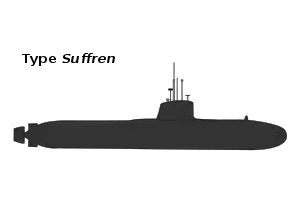Barracuda-class submarine (France)
The Barracuda class (or Suffren class) is a nuclear attack submarine, designed by the French shipbuilder Naval Group (formerly known as DCNS and DCN) for the French Navy. It is intended to replace the Rubis-class submarines. Construction began in 2007 and the first unit was commissioned on November 6, 2020. Full operational capability is not anticipated until 2021.[6]
 | |
| Class overview | |
|---|---|
| Name: | Barracuda class |
| Builders: | Naval Group (formerly known as DCNS and DCN) |
| Operators: |
|
| Preceded by: | Rubis class |
| Cost: | |
| Built: | Since 2007 |
| In commission: | From 2020 (originally planned for 2017) |
| Planned: | 6 |
| Building: | 5 |
| Completed: | 1 |
| General characteristics | |
| Type: | Nuclear attack submarine |
| Displacement: |
|
| Length: | 99.5 m (326 ft) |
| Beam: | 8.8 m (29 ft) |
| Draught: | 7.3 m (24 ft) |
| Propulsion: |
|
| Speed: |
|
| Range: | Unlimited range, 10 years (nuclear fuel) |
| Endurance: | 70 days of food [3] |
| Complement: |
|
| Sensors and processing systems: |
|
| Armament: |
|
History
In October 1998, the Delegation Générale pour l'Armement, the French government's defense procurement agency, established an integrated project team consisting of the Naval Staff, DCN (now known as Naval Group), Technicatome and the Commissariat a l'Énergie Atomique, a regulatory body that oversees nuclear power plants, to oversee the design of a new attack submarine class.[7] DCN was to be the boat's designer and builder while Technicatome (since acquired by Areva) was to be responsible for the nuclear power plant. The two companies were to act jointly as a single prime contractor to share the industrial risks, manage the schedules, and be responsible for the design's performance and costs, which at the time was estimated to be US$4.9 billion.[7]
On 22 December 2006, the French government placed a €7.9 billion order for six Barracuda submarines with Naval Group and their nuclear power plants with Areva-Technicatome.[8] According to the DGA “Competition at the subcontractor level will be open to foreign companies for the first time.”[9] According to the contract, the first boat was to commence sea trials in early 2016, with delivery occurring in late 2016/early 2017. This was to be followed by entry into service in late 2017.[10]
Naval Group also designed a conventionally powered derivative, dubbed the SMX-Ocean, featuring fuel cells and vertical launchers.[11] Another conventionally powered design, the Shortfin Barracuda, was selected as a future replacement for the Collins-class vessels with the Royal Australian Navy.[12]
In 2016, Naval Group also began to position itself and its Shortfin Barracuda design to the Royal Canadian Navy's Future Canadian Submarines project. The project was envisaged as replacing the Victoria-class submarines by 2030,[13] however no order was placed by the Canadian Government.
Naval Group is also offering a version of the "Shortfin" diesel-electric variant as replacement for the current Walrus-class submarines of the Royal Netherlands Navy, competing against the A26 design by Saab and Damen.
Description
Barracudas will use technology from the Triomphant class, including pump-jet propulsion. This class reportedly produces approximately 1/1000 of the detectable noise of the Redoutable-class boats (submarines), and they are ten times more sensitive in detecting other submarines.[14] They will be fitted with torpedo-tube-launched cruise missiles MDCN SCALP Naval for long-range (well above 1,000 km, 620 mi) strikes against strategic land targets. Their missions will include anti-surface and anti-submarine warfare, land attack, intelligence gathering, crisis management and special operations.
The Barracuda class nuclear reactor incorporates several improvements over that of the preceding Rubis. Notably, it extends the time between refueling and complex overhauls (RCOHs) from 7 to 10 years, enabling higher at-sea availability.
In support of special operations missions, Barracudas may also accommodate up to 15 commandos, while carrying their equipment in a mobile pod attached aft of the sail.[3]
Specifications
Designed by Naval Group and TechnicAtome, this classe has the following capabilities:
- SYCOBS combat system with :
-
Sensors Hull and flank sonar arrays Thales UMS-3000 Towed sonar array unknown - VLF Mine and obstacle avoidance Thales SEACLEAR Active sonar warning receiver Thales VELOX-M8 Navigation Sonar Thales NUSS-2F Mk2 Attack photonics mast Sagem Série 30 AOM Surveillance photonics mast Sagem Série 30 SOM -
Weapons 4 tubes + 20 weapon racks with a mix of : F21 Artémis Heavyweight wire-guided torpedo MdCN Land attack cruise missile Exocet SM39 mod2 Anti-ship missile FG29 acoustic mine D-19 UUV A3SM (VL MICA NG) Surface to air missile
- Thales PARTNER communication system with :
- Thales DIVESAT communications mast with SYRACUSE satellite link.
- L11, L22 and L16 data-links
- Thales TUUM-5 Mk2 underwater telephone and emergency beacon
- NEMESIS countermeasure system (based on CONTRALTO) from Naval Group which applies a "confusion / dilution" principle and combines evasive maneuvers with the deployment of Canto-S decoys.
- Nuclear-electric propulsion (NEP) where the screw is turned by an electric motor and not a steam turbine with reduction gearing like most other submarines. This is quieter and allows integration of batteries to further quieting.
- TechnicAtome K15 150 MW reactor.
- 2x 10MW turbo-generator groups.
- Large batteries that allow the submarine to run at minimum reactor power for several days in near perfect quiet.
- 2x SEMPT Pielstick 480 kW each emergency diesel generators.
- Large endurance :
- Ten years of nuclear fuel.
- 70 days of food.
- Removable dry dock for PSM3G six-seat special-forces submarine and room.
Boats
| Pennant no. | Name | Laid down | Launched | Commissioned | Full Operating Capability | Homeport |
|---|---|---|---|---|---|---|
| Q284 | Suffren | 19 December 2007 | 12 July 2019[15] | November 6 2020 | Expected in 2021 | Toulon |
| [data unknown/missing] | Duguay-Trouin | 26 June 2009 | Expected by 2021 | Expected by 2022[16] | Expected by 2023 | Toulon |
| [data unknown/missing] | Tourville | 28 June 2011 | Expected by 2022 | Expected 2024[17] | Expected by 2024/25 | Toulon |
| [data unknown/missing] | De Grasse[18] | [data unknown/missing] | Expected by 2024 | Expected by 2026[19] | Expected by 2026/27 | Toulon |
| [data unknown/missing] | Rubis[18] | [data unknown/missing] | Expected by 2026 | Expected by 2028[20] | Expected by 2028/29 | Toulon |
| [data unknown/missing] | Casabianca[18] | [data unknown/missing] | Expected by 2028 | Expected by 2030[21] | Expected by 2030/31 | Toulon |
Shortfin Barracuda conventional variant
 Profile of the Shortfin Barracuda conventional variant. | |
| Class overview | |
|---|---|
| Name: | Shortfin Barracuda Block 1A |
| Builders: | Naval Group (formerly known as DCNS and DCN) |
| Operators: |
|
| Preceded by: | Collins class |
| Cost: | |
| In commission: | Approx. 2030–2070 (planned) |
| Planned: | 12 |
| Building: | 0 |
| Completed: | 0 |
| General characteristics | |
| Type: | Diesel-electric attack submarine |
| Displacement: | over 4,000 t submerged |
| Length: | 97 m (318 ft) |
| Propulsion: |
|
| Range: | 18,000 nm |
| Endurance: | 90 days submerged |
| Complement: |
60 crew 12 clearance divers |
| Armament: |
8 x 533mm torpedo tubes Payload: 28 torpedoes mix of: Mk 48 torpedoes, Harpoon anti-ship missiles, A3SM (MICA) anti-air missiles or Mk III Stonefish mines |
Naval Group submitted a conventionally powered diesel-electric variation to the design – named the Shortfin Barracuda Block 1A, a derivative of the SMX Ocean concept – to the competitive evaluation process (CEP) phase of Australia's Collins-class submarine replacement. "While exact details remain confidential, DCNS can confirm the Shortfin Barracuda is over 90 metres in length and displaces more than 4,000 tons when dived," said Sean Costello, CEO of Naval Group Australia.[24] Naval Group was chosen by the Australian Government on 26 April 2016 to build twelve of the Shortfin Barracuda Block 1A variant at a projected AU$50 billion (US$35.7 billion). Much of the works will be undertaken at ASC Pty Ltd in Adelaide, South Australia.[25][26] Construction is expected to begin in 2020 or 2021.[27]
The class will be known as the Attack-class submarine with the first vessel named HMAS Attack.
See also
References
- "Projet de loi de finances pour 2015 : Défense : équipement des forces" (in French). Senate of France. 20 November 2014. Retrieved 9 January 2020.
- "France's Future SSNs: The Barracuda Class". Defense Industry Daily. 28 October 2014. Retrieved 22 November 2014.
- "Nouvelle génération de torpille lourde pour la Marine nationale : la F21" (PDF). Naval Group. October 2008. Archived from the original (PDF) on 12 November 2008. Retrieved 20 May 2010.
- Vavasseur, Xavier (8 February 2015). "Exclusive Interview With The French Navy On The Barracuda SSN Program". navy-recognition.com. Retrieved 1 July 2015.
- https://www.navalnews.com/event-news/euronaval-2020/2020/10/euronaval-france-to-repair-fire-damaged-ssn-perle-with-forward-section-of-ssn-saphir/
- Preston, Antony (1 October 2002). "France unveils plans for new barracuda SSNs". Sea Power. Archived from the original on 24 September 2015. Retrieved 18 May 2015 – via HighBeam Research.
- "France orders six 'Barracuda' class nuclear-driven submarines". Agence France Presse. 22 December 2006.
- Navy League of the United States - Citizens in Support of the Sea Services Archived 30 March 2006 at the Library of Congress Web Archives
- "Les noms des futurs sous-marins nucléaires français dévoilés". Mer et Marine. 28 May 2007. Retrieved 29 April 2016.
- "SMX® Ocean Conventionally Powered Attack Submarine, France". naval-technology.com. Retrieved 16 September 2015.
- Scott, Jason; Whitley, Angus. "France's DCNS Wins $39 Billion Australian Submarine Contract". Bloomberg L.P. Retrieved 26 April 2016.
- "DCNS : La nouvelle FREMM ER dévoilée à Ottawa". meretmarine.com. 27 May 2016. Retrieved 18 February 2017.
- "SNLE-NG Le Triomphant". netmarine.net. Archived from the original on 21 May 2014. Retrieved 22 November 2014.
- "France launches first Barracuda SSN | Jane's 360". www.janes.com. Retrieved 12 July 2019.
- https://www.navyrecognition.com/index.php/focus-analysis/naval-technology/9239-analysis-suffren-barracuda-class-new-nuclear-powered-attack-submarine-for-the-french-navy.html
- https://www.meretmarine.com/fr/content/marine-nationale-les-programmes-qui-vont-faconner-la-future-flotte-francaise
- "Programme Barracuda : mer en vue pour le Suffren" (in French). Ministry of Defence of France. 23 July 2013. Retrieved 13 August 2015.
- https://www.meretmarine.com/fr/content/marine-nationale-les-programmes-qui-vont-faconner-la-future-flotte-francaise
- https://www.meretmarine.com/fr/content/marine-nationale-les-programmes-qui-vont-faconner-la-future-flotte-francaise
- https://www.meretmarine.com/fr/content/marine-nationale-les-programmes-qui-vont-faconner-la-future-flotte-francaise
- https://www.reuters.com/article/us-australia-defence-submarines-idUSKCN1Q002H
- https://www.defenseworld.net/news/26898/Australia_to_spend__90B_for_12_Attack_class_Submarines
- "DCNS unveils Shortfin Barracuda" (Press release). Naval Group. 15 July 2015. Retrieved 20 October 2015.
- "France wins $50b contract to help build Australia's new submarines" (Press release). Retrieved 26 April 2016.
- Starick, Paul (26 April 2016). "$50bn Future Submarines to be built at Osborne in Adelaide by French firm Naval Group". The Advertiser. Retrieved 26 April 2016.
- "Submarine project boosts France-Australia ties". SBS. AAP. 9 July 2017. Retrieved 10 July 2017.
External links
| Wikimedia Commons has media related to Suffren class submarines. |
- DCN official site at the Wayback Machine (archived 29 February 2008)
- France unveils plans for new Barracuda SSNs at the Library of Congress Web Archives (archived 30 March 2006)
- France’s Future SSNs: The Barracuda Class at Defense Industry Daily.
